

– Download larger image (with additional data) as a PDF –
Yesterday I shared some encouraging news about fatal bike crashes in Portland. Despite what headlines and hyperbole might lead you to believe, 2010 was the fifth year since 2000 that there were zero bicycle fatalities on the streets of Portland.
That’s good news if you ride a bike around town; but you’ll also be glad to know that new data released by PBOT today shows a downward trend in traffic fatalities in Portland across all modes. In fact, 2010 had the lowest number of motor vehicle fatalities since 1925. In the past 15 years, the number of motor vehicle fatalities in Portland has been reduced from 41 to 11.
In addition, 2010 had the second lowest amount of total traffic fatalities since they began keeping records in 1925. PBOT says “This continues a long-term, downward trend in fatalities that began in the mid-80s.”
Have better bikeways (and the bike traffic they attract) played a role in improving traffic safety for all Portlanders? It’s hard to prove, but it’s very likely.
Safer roads come from a wide mix of practices and policies — from signal timing to speed enforcement. While it’s not in any engineering manuals, it’s likely that more bikes does play a role. Here’s how writer and activist Elly Blue put in a recent Girst column on the “safety in numbers” concept:
“But when there are a lot of bicyclists on the road, according to this theory, drivers take notice. They become more attentive, slow down, pass more cautiously, double-check their blind spots, expect the unexpected. They sense that the road has become a more complicated place, and adjust their behavior accordingly. As a result, the road becomes safer, presumably for everyone.”
But it’s not all good news.
While the overall trend is downward, PBOT data also shows that the number of people killed while walking in Portland has shown a disturbing uptick in the past five years. 15 people died while walking on the streets of Portland in 2010; that’s up from just five in 2008 and you have to go back 14 years before there were more (17 in 1996).
An overall downward trend is encouraging, and it’s likely there will be even fewer fatal crashes in the years to come. While PBOT and the community can always do better (we’ll have to push even harder to change the transportation status quo), we have a strong foundation of partnerships, practices, and policies that is saving lives.
UPDATE: After we published this story, Mayor Adams and PBOT released an official press release about their 2010 traffic fatality data.


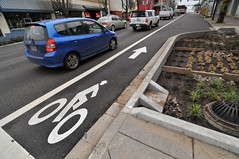
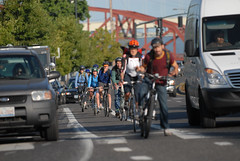
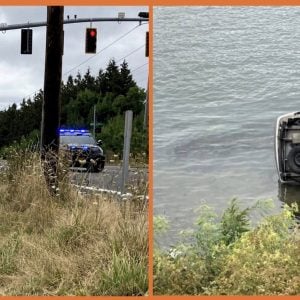

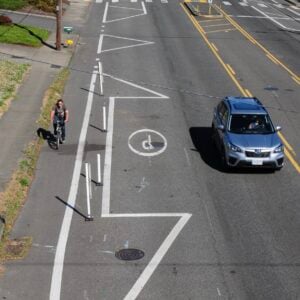
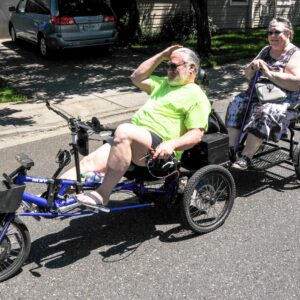
Thanks for reading.
BikePortland has served this community with independent community journalism since 2005. We rely on subscriptions from readers like you to survive. Your financial support is vital in keeping this valuable resource alive and well.
Please subscribe today to strengthen and expand our work.
Are there any stats on pedestrian fatalities that allow comparison based on per capita miles walked, or something like that?
If the increase in fatalities is greater than the increase in the use of pedestrian mode, then I would want to see money spent on finding and fixing the cause: do we need to educate people to lower the volume of their ear buds or flip back their hoodie blinders? But at this point it seems just as likely that money should be spent on sidewalk improvements.
Knowing that there is an absolute increase in fatalities is not as useful as determining whether there is a relative increase.
. Despite what headlines and hyperbole might lead you to believe, 2010 was the fifth year since 2000 that there were zero bicycle fatalities on the streets of Portland.
You do realize that some of the “headlines and hyperbole” come from this particular website, right?
fatal crashes mean nothing to me because that takes the focus off the crash on puts it on the result… crashing a car is much safer than it used to be so I would hope that fatal crashes would go down… but has the total number of crashes also gone down? or are people crashing just as much but not dying? only when total crashes go down while the same amount of people are driving will I be really impressed…
Yeah, that is a good point. I’d also like to see total NUMBER of non-fatal crashes by mode type as well…
total number is not an accurate representation. You want to look at frequency.
You can have a high population with a lower frequency and still have a higher total.
I would venture a guess to lower auto fatalities being linked to less recreational driving. When people drive to their jobs everyday they know that route very well and are aware of which lane to be in, blind spots, they are less distracted from the sights that they drive by everyday and more in tune to getting from A to B. Weekend drivers are horrible, they are making right turns from left lanes, miss turns, are checking out the shop on the corner… with the price of gas people don’t go for drives as much anymore
Nice to have the perspective that we’re headed in the right direction. TERRIBLY DISTURBING that the pedestrian numbers have skyrocketed. My mental review of this year’s fatalities leads me to believe that it’s impaired and/or careless drivers who have been responsible – not either “aggressive pedestrians” or impaired/distracted walkers.
This is a crucial issue and an inclusive one. Everyone is a pedestrian.
According to this Portland Tribune article (http://www.portlandtribune.com/news/story.php?story_id=24129) there were 16 pedestrian deaths in Portland in 2003, and 5 through the first 4 months of 2004 (I can’t find a good source online for pedestrian deaths over the last decade).
The point is that 2010 was a bad year, but not out of the range of what Portland would call normal in the last decade.
it also might be a function of trying to make things pedestrian oriented.
In a system that is car-centric and not walking friendly, i expect there to be less actual pedestrian travel and likely lower fatalities as a result.
Ditto the comment on crashes vs. fatalities. I read that the drop in murders over the last 20 years might have more to do with advances in trauma care and emergency response, not that fewer people are getting shot or stabbed.
I also wonder how fewer traffic deaths correlates with the overall decrease in driving, which most people attribute to the recession. Fewer jobs and less freight means fewer drivers, less congestion, and perhaps fewer fatalities. Would need more analysis to draw these connections.
Still, it’s interesting data, and obviously a favorable trend, whatever the cause!
The continuing decrease in automotive fatalities has been widely attributed to two factors:
1. The economic downturn. People have been driving less since 2007.
2. Improved vehicle safety. Widespread adoption of side airbags and stability control in newer cars, along with overwhelming inclusion of front airbags and ABS in older cars, have made cars far safer than before.
However, as cars have become safer there has been a gradual societal shift over the past two decades to make the vehicle, rather than the driver, responsible for safety.
On balance that is a good thing, but it has also lulled many drivers into complacency, and combined with new electronic distractions we now have widespread inattentive driving on a level that was unthinkable 20 years ago.
Despite much sloppier driving, fewer vehicle occupants are dying than before because our cars are saving our ass. Unfortunately non vehicle occupants don’t benefit from all these fancy safety advances, and it should be no surprise that more and more pedestrians are being murdered.
Let’s be careful how we throw around accusations of homicide, unless the intent is simply to poke a fight. I seem to recall that at least a couple of those pedestrian fatalities involved someone walking on and/or crossing the freeway, which seems like an incredibly bad idea to me. I’m not trying to diminish the seriousness of these deaths- just saying it’s probably not appropriate to indiscriminately assign blame. Up until that last word, however, I was nodding my agreement with your post. It’s distressingly less and less common to observe drivers in the classic 10-and-2, eyes-on-the-road posture.
“murdered”? That implies intent.
While you happily place the blame on the automobile, you may wish to consider that making things more pedestrian oriented is going to drive the statistics as well. More people ambulating equals more chances for accidents.
While cars may be safer overall, you imply that somehow that makes people more sloppy drivers. I don’t car how safe or unsafe a car is…nobody wants to GET into an accident. It’s not like “Hey, my car is safe how about I go plow into that group of pedestrians”. The driver (from both an evolutionary and financial perspective will seek to avoid potential harm to themselves.
“More people ambulating equals more chances for accidents.” I suppose, but if infrastructure is designed with those ambulators in mind, then the likelihood of accidents can be mitigated. I think part of the problem might have to do with high-traffic areas that are inhospitable to pedestrians, for instance: busy streets with no sidewalks, crosswalks and/or traffic signals too far apart.
OK, you’re right: “murdered” goes a bit too far. It’s still homicide though, even if death is not the intended outcome. Vehicles are deadly weapons, often wielded carelessly; even if the intent is not to kill, the intent to wield the weapon still exists.
But as to rigormrtis’ second point: there is absolutely NO QUESTION in my mind that drivers have gotten sloppier and less attentive over the years. I suppose part of the difference could be that I grew up in a state with mandatory Drivers’ Ed (and a powerful vehicular homicide law), but when I learned to drive in the 80s it seemed most people recognized that driving was an inherently dangerous activity, and that cars were deadly weapons. Now that we have multiple airbags, active safety systems, far better crashworthiness, I don’t get the feeling that the average Joe on the street has that constant sense anymore.
I don’t think “more pedestrians” is driving the increase: The decrease in overall fatalities and increase in pedestrian fatalities are clear nationwide trends. We may have better facilities and more pedestrians locally, but I don’t believe that’s substantially true for the country as a whole.
“It’s still homicide though…”
I’d love to let this drop, but somehow I just can’t. Homicide is when one person is killed by another person or as a direct result of another person’s actions. Depending on circumstances, it may be categorized as criminal or not, justifiable or not, but if I wander onto a freeway at night and get run down… well some might say that there’s a driver to blame, but I know (doo doo doo doo doo) it’s my own damn fault (doo doo doo doo doo). My point is this: “murdered” does not go “a bit” too far; “murdered” goes way too far, particularly in the absence of context or specifics. I think we ought to try to refrain from kneejerk villification of motorists as a whole. If for no other reason, because this kind of incendiary language can be alienating and counterproductive when it comes to actually finding solutions to problems.
Heh. Wastin’ away again?
Si, el biciclero, en la villa de las margaritas.
Are we reading the same graph?
I see 4, 0, 6, 0, 4, 0… okay, what’s the next number in this pattern?
I see people drawing way too many conclusions from these statistics. When the numbers are as low as they are, a lot of it is just coincidence, don’t you think? Sometimes things just happen and there’s no trend, no reason, it just is.
Also, you said across the board traffic fatalities are down? Do the pedestrians not count?
Actually, the motor vehicle fatality counts compiled and reported by the federal government do not include pedestrians. The widely reported figure of 32,000 or so is of motor vehicle occupants only. Not 100% sure, but I believe that count excludes cyclists, too.
Pedestrian (and I think bicycling) deaths are recorded, but they are reported separately.
Why isn’t Angela Burke in the 2010 stats?
I suspect the poor economy resulting in fewer car miles driven is the major driver of that stat.
I suspect the poor economy resulting in more walking miles is the major driver of that stat.
this statistic for 2010 is not true. Angela Burke was killed in 2010 walking her bike on Barbur blvd. http://blog.oregonlive.com/commuting/2010/12/portland_memorial_vigil_planne.html